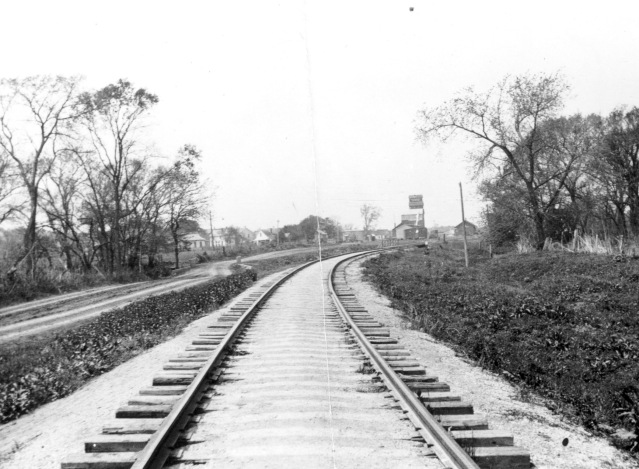
Dean Dunn took this photograph from the Atchison, Topeka, & Santa Fe tracks just east of the Eskridge Co-op and the Eskridge depot, visible in the distance.
The history of Wabaunsee County, as well as the history of Kansas, cannot be told without paying tribute to the role of the American railroad industry. At the time of Wabaunsee County’s creation in the late 1850s, not only were there no railroads in Wabaunsee County, there were none in Kansas.
The United States government recognized the importance of the railroad in the development of the infrastructure of the nation, and particularly, lawmakers believed that private railroads could greatly aid the development of the American West, which included all of the land west of the State of Missouri.
With the passage of several pieces of legislation, including the Pacific Railroad Act of 1862 and the revised Railroad Act of 1864, American railroads were given millions of acres of land owned by the federal government, located in twenty mile-wide swaths along the right-of-ways of various rail lines. The American railroad industry became the real estate developers of the nation, creating towns along their lines to provide for train refueling, while selling lands to settlers and encouraging population growth in previously unsettled areas.
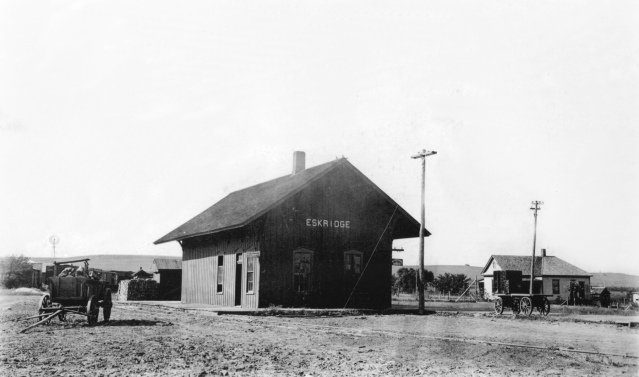
The Manhattan Alma and Burlingame Railroad depot at Eskridge is seen in this photo, circa 1890. As this depot is seen, it was originally 42 feet in length; in 1918 it was lengthened by 15 feet. Notice the stack of bricks which have arrived by train.
Additionally, telegraph lines were strung along railroad right-of-ways, providing communications for crews while constructing the rail line, and when complete, provided telegraph service to areas previously not served.
In Wabaunsee County the first opportunity for rail service came just after the Civil War from the Atchison, Topeka and Santa Fe Railway (ATSF), a railroad then in its infancy. The company was seeking various right-of-ways for a railroad system of connecting lines to run from Atchison, Kansas to Santa Fe, New Mexico. In 1865 the ATSF asked the Wabaunsee County Commissioners to approve bonds in the amount of $100,000 to construct a rail line through the country. The Commissioners pared the proposal to $50,000 and put the matter to a countywide vote on February 25, 1866. The bond proposal failed at the polls by a vote of 127-49.
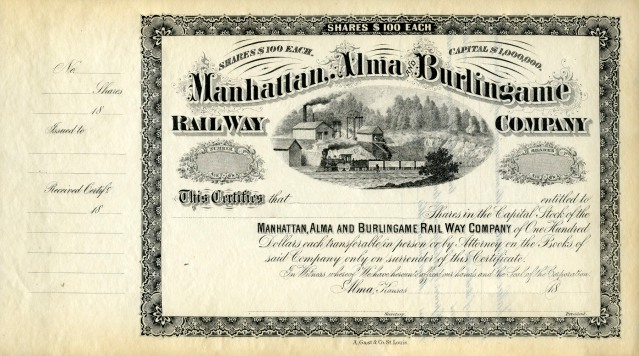
This stock certificate for $100 per share was prepared for issue by the Manhattan, Alma & Burlingame Railway Company. Courtesy Ed Hoover.
The ATSF pursued another route to the south, bypassing Wabaunsee County entirely, reaching Dodge City, Kansas in 1872. Residents of Wabaunsee County witnessed growth in towns along the railroad lines being built in the eastern half of Kansas, while growth stagnated in their own county. By 1871 Wabaunsee County residents were hungry for the railroad line they had rejected just five years earlier. On August 29, 1871 Wabaunsee County voters approved $160,000 in bonds for the construction of the Lawrence, Topeka and Solomon City Railroad, which proposed a line through the county by a vote of 438-374. However, when Shawnee County officials learned that, despite the railroad’s name, the proposed line would pass well to the south of Topeka and not even have a depot in the city, they cancelled the bond election scheduled for August 31, 1871 and the proposed railroad never materialized.
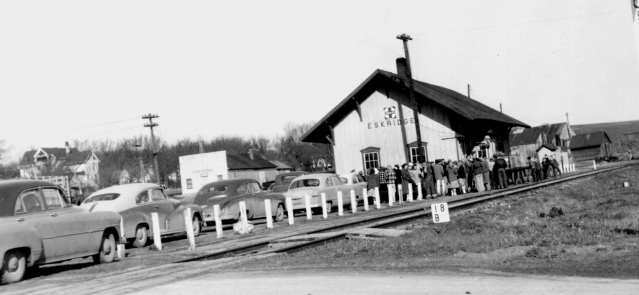
A crowd waits for a train at the Eskridge ATSF depot in this early 1950s photograph. Notice the Eskridge Star Grange to the left of the depot in this view and Dr. Coffey’s house at the far left. Photo courtesy Eskridge Public Library.
The residents of Wabaunsee County were now even more anxious for its first railroad. On August 29, 1872, thirteen men, most of whom were from Wabaunsee County, gathered together to organize what would become the Manhattan, Alma, & Burlingame Railway Co., and the papers of incorporation were filed on September 3, 1872. . On October 21, 1872 officers of the railroad company were elected, and within a month a survey of the proposed line was underway. However, in 1873 the United States experienced a major recession and financial panic which had its roots in railroad speculation.
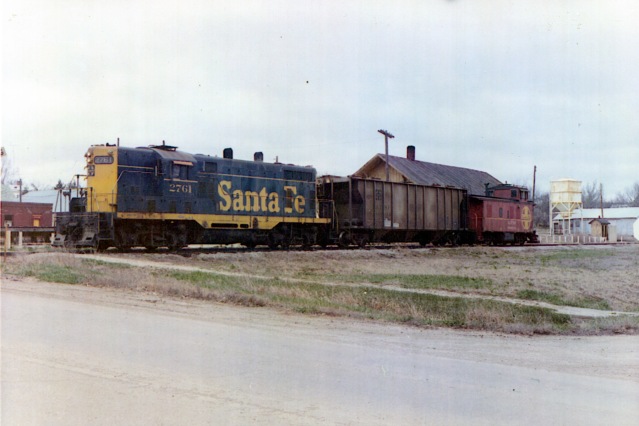
The last train which ran on the Atchison, Topeka & Santa Fe Railway tracks at Eskridge pulls out of the depot in this 1972 photograph by Eskridge businessman, Dean Dunn.
The M. A. & B. dream of a railroad languished for almost seven years. By 1879, economic recovery was underway, and the ATSF was eager to acquire more coal for its use and as a source of transportation revenue. On June 5, 1879 the Board of Directors of the proposed railroad met again, this time learning of the interest by the ATSF in creating a line to connect the coal fields near Burlingame with the ATSF’s main line in Manhattan, Kansas.
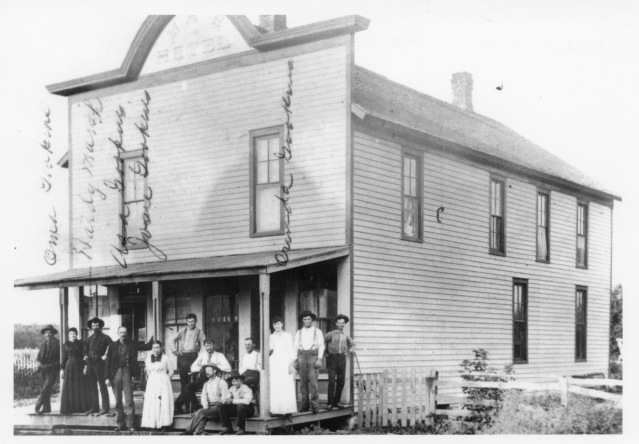
The Manhattan, Alma & Burlingame Hotel was located in Harveyville, Kansas, seen in this view, circa 1890.
On August 2, 1879, Wabaunsee county voters approved $138,700 in bonds to finance the portion of the new line which ran through their county. With the bonds approved, on February 18, 1880 the M.A.B. Board of Directors resigned, and ATSF executives took control of the M. A. & B Railway.

This Manhattan, Alma, & Burlingame Railway ticket is punched August 21, 1885 and shows ten towns listed as stops on the route.
The ATSF partnered with the Union Pacific Railroad to finance the new line which was originally 56.62 miles in length, and the two railroads shared the ownership of the federally provided land grants attached to the proposed line. Work began on construction of the railroad immediately, and on July 5, 1880 the MAB arrived in Alma, and a gala celebration was held in the city with five bands performing and over 5,000 people in attendance. The excitement over the coming of railroad service to the county teemed across the county, especially in the towns which the rail line served. By July 18th, the rail line had reached the town of Wabaunsee, and by the end of the month trains were traveling along the entire line.

The ATSF locomotive number 2761, also known as “Old Polly” pulls out of the depot at Harveyville for the last time in this view from 1972.
On April 18, 1898 the M. A. & B. was sold under foreclosure. In the course of the sale, 22.32 miles of track from Alma to Manhattan were dismantled and a new corporation, the Burlingame & Northwestern Railway Co. was formed, owned entirely by the ATSF which purchased all of the Union Pacific’s interest in the line. The ATSF operated the remaining line from Burlingame to Alma for the next 75 years.
During the first half of the 20th century, there was not a single paved highway in Wabaunsee County, so during this era, the railroad provided reliable transportation for those traveling in the county. However, major changes in Kansas transportation swept the state during the 1950s, as the Kansas Highway Commission and later the Kansas Department of Transportation expanded the role of “365-day roads” and paved highways were constructed across the state and through Wabaunsee County.
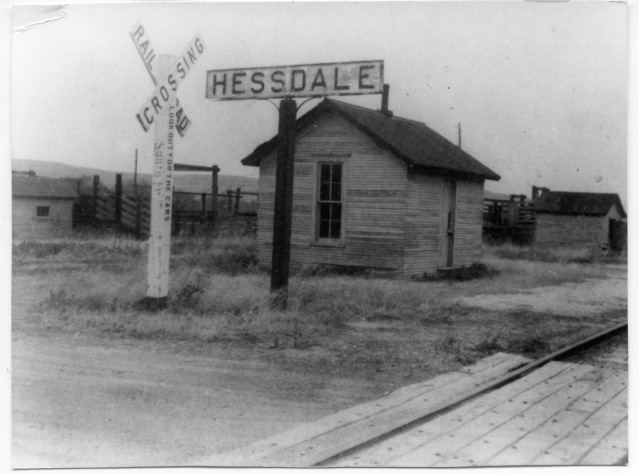
The Hessdale ATSF depot and stockyards are seen in this photograph taken in 1960 at the crossing of Hessdale Road and the railroad track.
As the 20th century passed and highways became the norm, the ATSF’s short line became less and less important to the movement of passengers and freight in the county. The line still provided significant service to Wabaunsee County ranchers as a source of transportation of cattle in and out of the county. Tens of thousands of head of cattle were moved into the county, annually, to graze on the lush tallgrass prairie, arriving in cattle trains comprised of wooded cattle cars. In the early 1960s the railroads experienced increasing regulations regarding the transportation of livestock, and by 1962 the last cattle train had departed Wabaunsee County.
In 1972 the ATSF announced that the line from Burlingame to Alma would be closed and sold by the end of the year. A group of Wabaunsee County citizens formed an organization to raise the necessary $200,000 required to purchase the line, which they hoped would become a tourist attraction, offering excursion train rides through the scenic Flint Hills. The ATSF had set a deadline of December 1972 for the organization to raise the money, but when the deadline arrived, the effort fell $20,000 short of its goal, and the railroad line was sold to metal scrappers. Within another year, the steel rails and railroad ties were removed and sold, and Wabaunsee County’s first railroad was no more.
Categories: Early History, Gallery

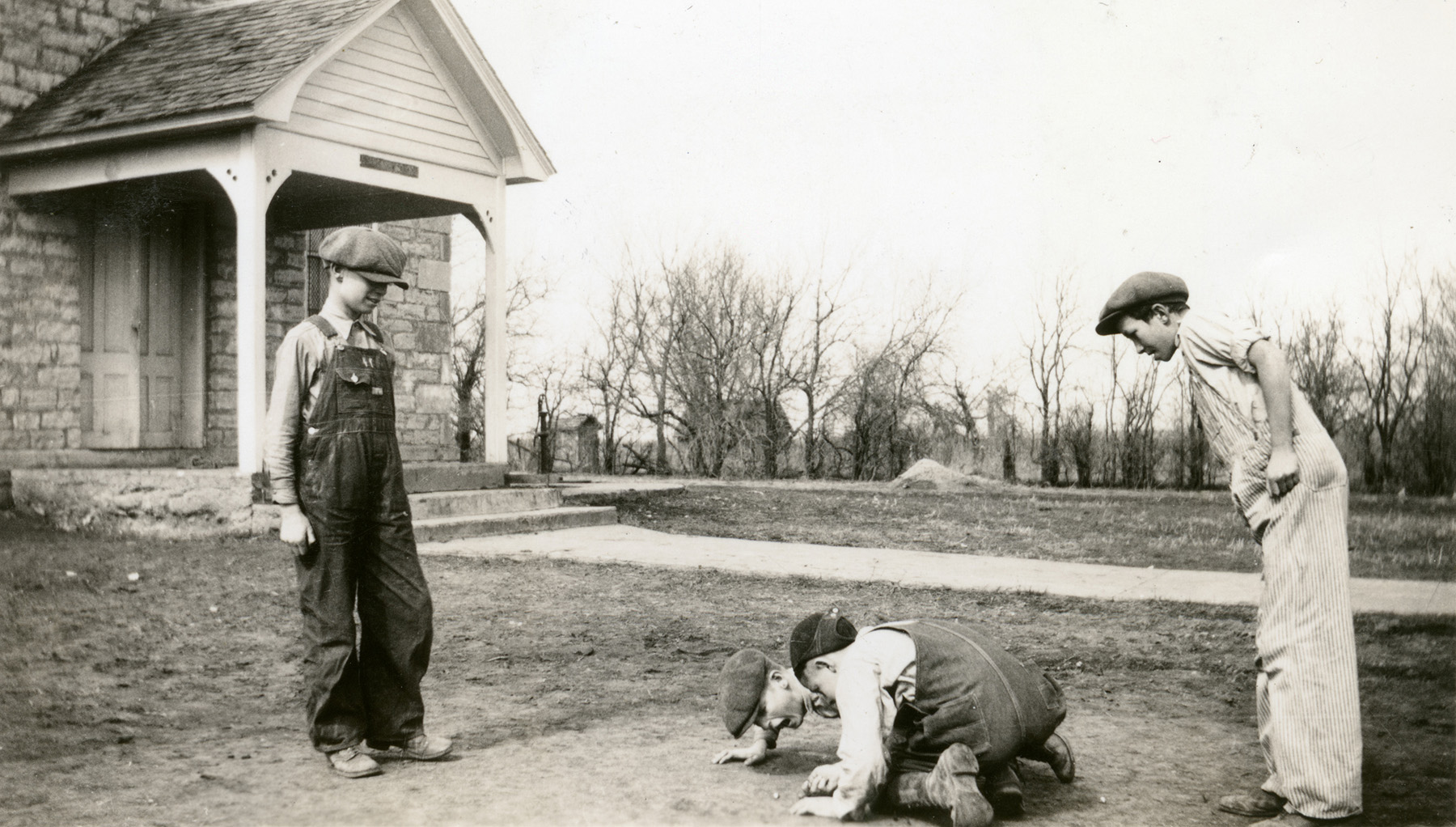












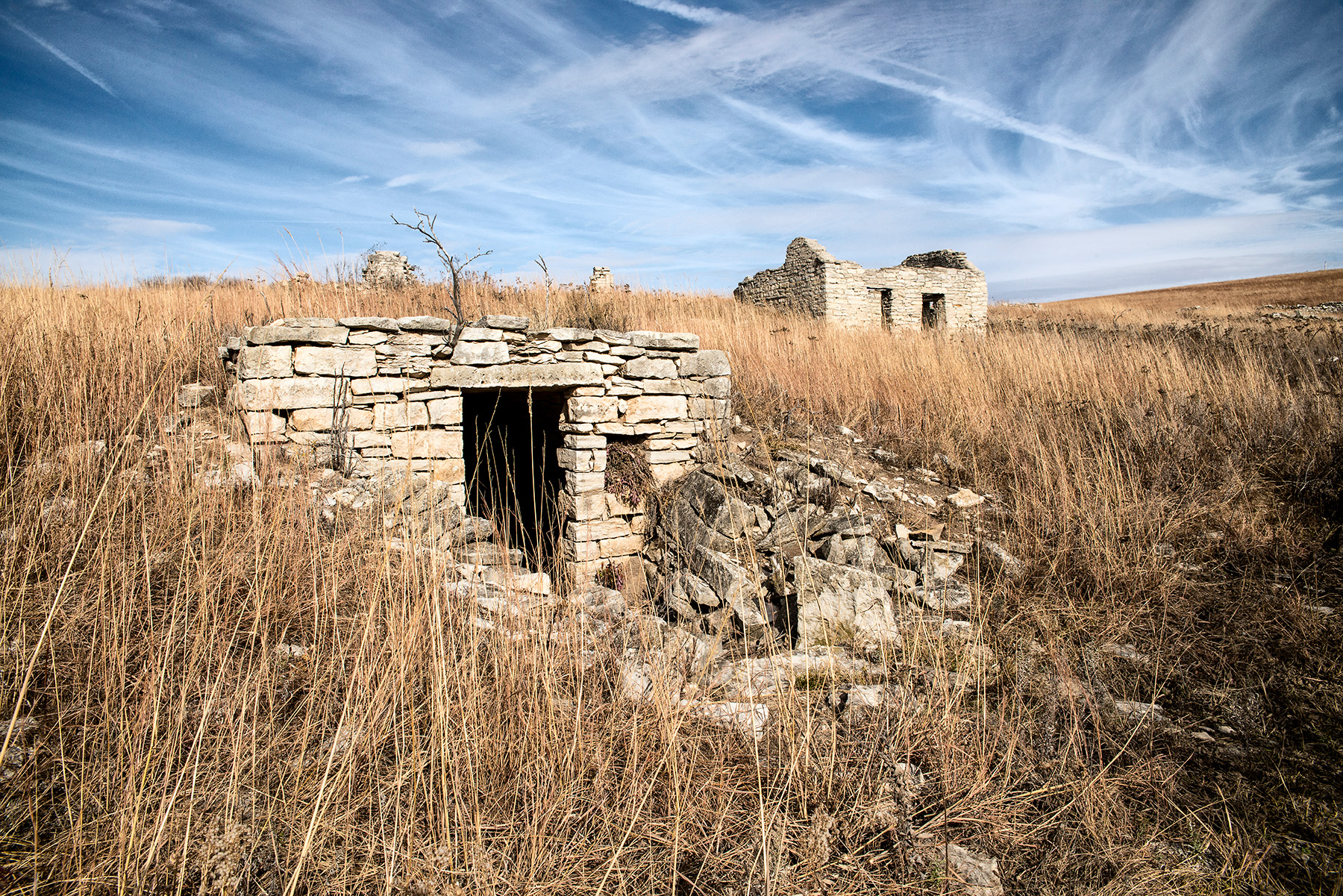
Regarding “Old Polly” and the MAB, I have several remembrances from the 1950’s. At that time, Polly was making two roundtrips per week through Eskridge, plus the special cattle trains. My family lived across the street north of the depot for a couple of years (52-54). Perhaps my standout memory concerns a special chartered “excursion” train which transported Eskridge Grade School children to the Ringling Bros. Circus in Topeka. I’m not certain of the year, but I must have been about 10 (1960) when it happened. I believe the depot master, Ed Foose, assisted the Eskridge P.T.A. to organize the trip. The special train stopped on the railroad tracks just north of Eskridge Grade School. Grade school students were all supplied with sack lunches and then we trouped out across the football field to board the train. I remember that to get onto the passenger cars, steps were placed on the gravel beside the train car entrances so we could carefully make our way up onto them and into the cars. First, we traveled to Burlingame where we joined the main Santa Fe rail line northeast to Topeka. We arrived at the small Santa Fe passenger station just east of downtown Topeka’s Municipal Auditorium (where the circus was staged). We disembarked and walked with our teachers and our “room mothers” a few blocks up to the auditorium. When we arrived, we were seated in the auditorium balcony according to our class rosters. During the circus we saw the usual entertainment. We enjoyed the elephant show, the taming of the lions, trapeze artists, and of course – the clowns. Some of us bought small turtles, while others bought chameleons for souvenirs. It was quite a day. I don’t remember riding the train home, but we must have done so. I was probably worn out from such an exciting day.
LikeLiked by 1 person
My grandparents Hjalmer F an Blossom L Johnson lived at Bradford between Eskridge an Harveyville I can remember seeing Polly go by when I was a kid in the 1960’s. The old roadbed runs through my uncles pasture just west of Eskridge.
LikeLike
An interesting, but convoluted history. I’ve read this twice and still don’t understand everything about it.
LikeLike
Greg:
Are you aware of any maps that show the route taken between the 10 towns. Dan
LikeLike